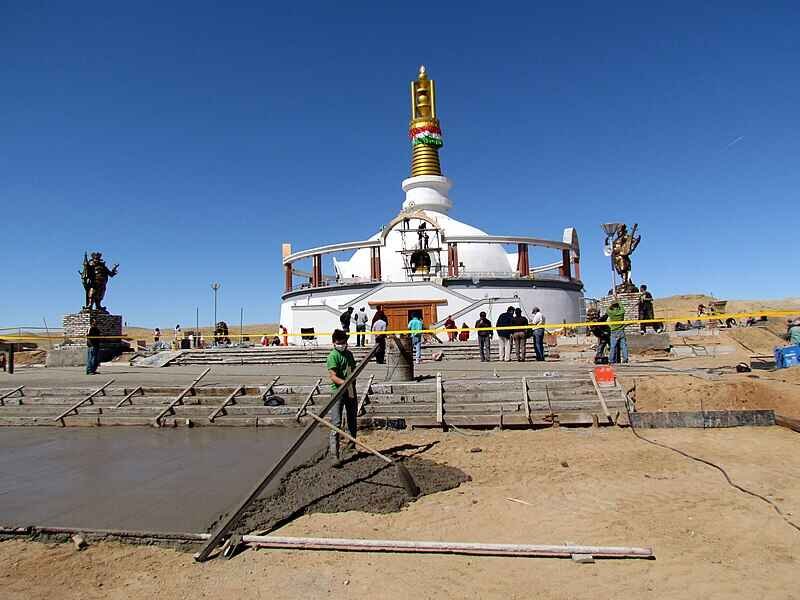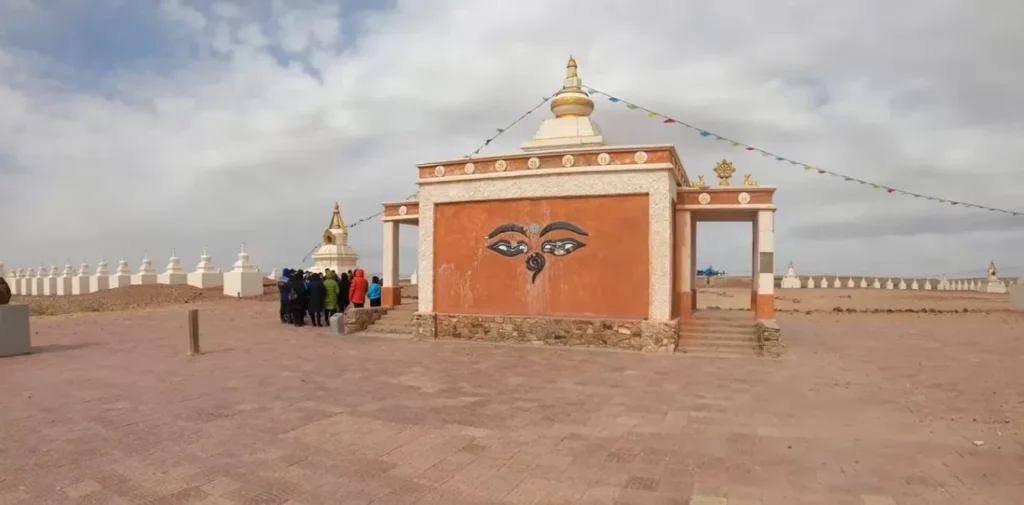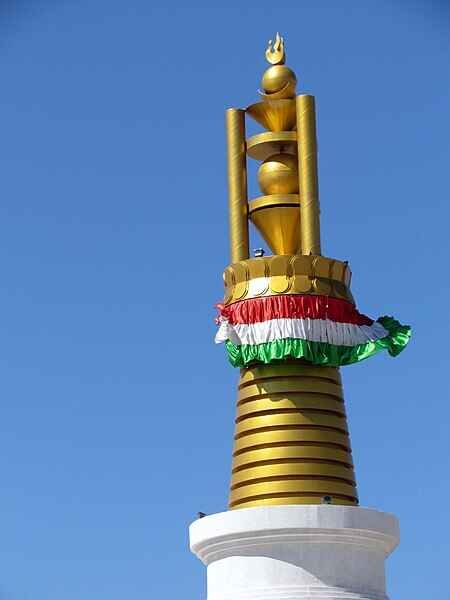Nestled amidst the vast, windswept expanses of the Gobi Desert, Khamariin Khiid Monastery stands as a beacon of Mongolia’s rich spiritual heritage and cultural resilience. Founded in the early 19th century by the visionary monk Danzanravjaa, this sacred site has weathered the storms of history, from its flourishing days as a vibrant center of Buddhism to its near destruction during the tumultuous political upheavals of the 20th century.
Today, Khamariin Khiid Monastery not only serves as a sanctuary for spiritual seekers and pilgrims but also as a living testament to the enduring legacy of Mongolian Buddhism.
With its stunning architecture, serene landscapes, and deep-rooted traditions, Khamariin Khiid Monastery invites visitors to explore a world where faith, art, and history intertwine in harmonious beauty. Join us on a journey through time as we delve into the captivating story of Khamar Monastery—an oasis of tranquility and enlightenment in the heart of Mongolia.

History of Khamariin Khiid Monastery
Khamariin Khiid Monastery was established during a time when Buddhism was experiencing a revival in Mongolia. Danzanravjaa, a charismatic figure known for his educational reforms and artistic contributions, chose the site for its perceived spiritual energy, believed to be enhanced by the surrounding Gobi Desert landscape.
At its height, Khamariin Khiid Monastery became a vibrant center for both religious practice and cultural activities, housing over 80 temples and accommodating around 500 monks.
The monastery was not just a place of worship; it also served as an educational institution. It included a library, a museum, and even Mongolia’s first professional public theater, known as Namtar Duulakh Datsan, which showcased performances across the Gobi region.
Additionally, it offered secular education through Khuukhdiin Datsan, teaching subjects like literature, mathematics, and natural science.
However, Khamariin Khiid Monastery faced severe challenges during the 1930s under the Stalinist regime led by Khorloogiin Choibalsan. As part of a broader campaign against Buddhism, many monks were executed or forced to abandon their monastic lives. The monastery itself was destroyed in 1937, leading to a significant loss of cultural heritage.
Legends of Khamar Monastery
Khamariin Khiid Monastery is steeped in legends that add to its mystical allure. One of the most famous legends is that of the Shambala, a sacred site within the monastery complex believed to be the center of the world’s spiritual energy.
Pilgrims visit this site at dawn to absorb the spiritual energy, often walking barefoot to feel the warmth emanating from the ground.
Another legend speaks of the 108 meditation caves surrounding the monastery. Monks would retreat to these caves for intense meditation sessions lasting 108 days, a number considered sacred in Buddhism. These caves are still visited by those seeking spiritual enlightenment and tranquility.
Reconstruction and Modern Significance
Following the democratic revolution in Mongolia in 1990, efforts to restore Khamariin Khiid Monastery began. The reconstruction was completed in 2006, allowing it to once again serve as a spiritual center for Buddhists.
Today, it is recognized not only for its historical significance but also as an energetic center believed to connect practitioners with Northern Shambhala—a mythical realm in Tibetan Buddhism.
The modern Khamariin Khiid Monastery attracts pilgrims and tourists alike. Visitors often engage in rituals aimed at absorbing the earth’s energy by lying on the desert sand. The site continues to host various religious ceremonies and serves as a place for meditation and reflection.

Dulduityn Danzanravjaa: The Enlightened Saint of the Gobi
Dulduityn Danzanravjaa (1803–1856) was a multifaceted figure in Mongolian history, renowned as a poet, playwright, painter, composer, and physician. He was recognized as the Fifth Noyon Khutagt, a title given to the incarnate lamas of the Nyingma lineage of Tibetan Buddhism in Mongolia.
Early Life and Recognition
Born into a poor family, Danzanravjaa’s early life was marked by hardship. His mother passed away when he was young, and he and his father survived by begging and singing.
At the age of five, he was recognized as the reincarnation of the Gobi Noyon Khutagt, a significant spiritual leader. Despite the Qing Dynasty’s ban on recognizing reincarnations, Danzanravjaa’s spiritual potential was acknowledged by prominent Buddhist leaders, including the Dalai Lama.
Contributions to Culture and Education
Danzanravjaa was a visionary who believed in the power of education and cultural development. He established the Khamariin Khiid Monastery in 1820, which became a center for learning and the arts.
The monastery housed Mongolia’s first professional public theater, a public library, and a museum. His commitment to education extended to founding a school that offered a secular curriculum, a rarity in pre-revolutionary Mongolia.
Personal Life and Legacy
Known for his unconventional lifestyle, Danzanravjaa embraced the Nyingma tradition, which did not require celibacy. He was open about his relationships and often referred to himself as a “boozer” in his writings. His literary works include over 300 poems, numerous songs, and several plays, reflecting his deep engagement with Mongolian culture and society.
Architectural Marvels and Sacred Sites within Khamariin Khiid Monastery
While much of the original structure was destroyed during the Soviet-era purges in the 1930s, efforts have been made to restore Khamar Monastery to its former glory. Today, visitors can admire the reconstructed temples, stupas, and other sacred structures that pay homage to Mongolian Buddhist architecture. The design of the buildings reflects a blend of traditional Buddhist styles and Mongolian cultural elements, showcasing the monastery’s significance as a meeting point of art, religion, and history.
Within the complex, there are several key sites of interest, including the Sermon Hall, which once hosted some of the most important teachings of Danzan Ravjaa. Visitors can also explore the restored meditation caves, where monks and practitioners have sought enlightenment for generations. These caves were integral to Khamar’s spiritual community, providing a secluded environment for deep meditation and contemplation.
One of the most fascinating aspects of the monastery is the Shambhala Energy Site, which is believed to be an earthly representation of the mythical Buddhist kingdom of Shambhala. Devotees claim that this sacred ground emits powerful energies that contribute to spiritual healing, making it a major attraction for both pilgrims and tourists.
Visiting Khamariin Khiid Monastery
Khamariin Khiid Monastery is located in the Khatanbulag district of Dornogovi Province, approximately 47 km south of the provincial capital Sainshand. Visitors can explore the rebuilt temples, meditation caves, and the serene desert landscape that continues to emanate spiritual energy. The site remains a testament to Mongolia’s rich cultural and spiritual heritage.

How can one visit the Khamariin Khiid Monastery from Ulaanbaatar
Visiting Khamariin Khiid Monastery from Ulaanbaatar is a journey that offers both spiritual and scenic experiences. Here’s a detailed guide on how to make the trip:
Travel Options
1. By Car:
Distance: Approximately 500 km (about 8 hours drive).
Route: Head southeast from Ulaanbaatar towards Sainshand, the capital of Dornogovi Province. From Sainshand, Khamariin Khiid Monastery is about 47 km south.
Road Conditions: The roads are generally in good condition, but it’s advisable to check for any travel advisories or weather conditions that might affect your journey.
2. By Train:
Route: Take a train from Ulaanbaatar to Sainshand. The train journey offers a comfortable and scenic view of the Mongolian landscape.
Duration: The train ride takes approximately 8-10 hours.
From Sainshand: You can hire a local taxi or arrange for a tour guide to take you to Khamar Monastery.
3. By Bus:
Route: Buses are available from Ulaanbaatar to Sainshand.
Duration: The bus journey takes around 8-9 hours.
From Sainshand: Similar to the train option, you can hire a taxi or arrange for a local guide to reach the monastery.
Guided Tours
Several tour operators offer guided tours to Khamar Monastery, which can include transportation, accommodation, and guided visits to the monastery and surrounding attractions. These tours often provide a more immersive experience, including visits to meditation caves, the Shambhala energy center, and other cultural sites.
What to Expect
Scenic Landscapes: The drive or train ride offers stunning views of Mongolia’s vast steppes and desert landscapes.
Cultural Experience: Engage with local nomadic culture, visit traditional Ger camps, and enjoy local cuisine.
Spiritual Sites: Explore the monastery, meditation caves, and the Shambhala energy center, believed to radiate powerful spiritual energy.
Tips for Travelers
Best Time to Visit: The best time to visit is during the warmer months, from May to September, when the weather is more favorable.
Preparation: Ensure you have enough water, snacks, and warm clothing, as the desert can get cold, especially at night.
Local Guides: Hiring a local guide can enhance your experience by providing deeper insights into the history and significance of the sites.
accommodation
When visiting Khamar Monastery, you have a few accommodation options to consider:
1. Guesthouses in Sainshand
Description: Sainshand, the nearest town to Khamar Monastery, offers several guesthouses. These provide basic amenities and are a convenient base for exploring the monastery and surrounding areas.
Booking: It’s advisable to book in advance, especially during peak pilgrimage times.
2. Ger Camps
Description: For a more authentic Mongolian experience, you can stay in a traditional ger (yurt) camp. These camps are located near the monastery and offer a unique way to experience the local culture and landscape.
Facilities: Ger camps typically provide beds, basic furnishings, and communal areas. Some camps may also offer meals and guided tours.
3. Camping Near the Monastery
Description: If you prefer a more adventurous stay, camping near the monastery is an option. This allows you to fully immerse yourself in the serene desert environment.
Preparation: Ensure you bring all necessary camping gear, including tents, sleeping bags, and sufficient food and water.
By following this guide, you can immerse yourself in the rich history and spiritual energy of Khamariin Khiid Monastery while enjoying the stunning landscapes of Mongolia.
♣♣You May Also Like: ⇓
- Noted Ongi Monastery In Mongolia: A Spiritual Oasis
- Erdene Zuu Monastery, Mongolia: A Vibrant Heritage
- Beautiful Wat Rong Khun: Thailand’s Famous White Temple
- Outstanding Yasaka Pagoda: A Timeless Landmark in Kyoto
- Ganesh Tok: A Spiritual Sojourn Amidst the Clouds
Conclusion
In the tranquil embrace of Mongolia’s vast landscapes, the Khamariin Khiid Monastery stands not just as a physical structure, but as a profound testament to the resilience and spiritual depth of Mongolian culture.
Rebuilt from the ashes of its turbulent past, the monastery today serves as a beacon of peace and a spiritual haven, inviting visitors from around the world to experience its serene environment and rich history.
Whether you are a seeker of spirituality, a student of history, or simply a lover of nature, Khamariin Khiid Monastery remains a poignant symbol of Mongolia’s heritage and a must-visit destination that holds the promise of an unforgettable journey into the soul of the steppes.
FAQs:
1. What is Khamariin Khiid Monastery?
Khamar Monastery, also known as Khamariin Khiid, is a significant Buddhist monastery located in the Gobi Desert of Mongolia, founded in 1820 by the monk Danzanravjaa.
2. Where is Khamariin Khiid Monastery located?
The monastery is situated approximately 47 km south of Sainshand in Dornogovi Province, Mongolia.
3. What happened to the monastery during the Stalinist purges?
Khamar Monastery was destroyed in 1937 during the communist purges in Mongolia, leading to the execution of many monks.
4. What is the significance of Shambala at Khamar Monastery?
Shambala is considered a sacred area within the monastery complex believed to radiate spiritual energy and is a focal point for rituals and meditation.
5. What types of rituals are performed at Khamariin Khiid Monastery?
Visitors can participate in rituals such as “burning sins,” lying on the ground to absorb energy, and offerings to sacred sites.
6. Can women participate in rituals at Khamariin Khiid Monastery?
Yes, women have historically been accorded greater respect and privileges at this monastery compared to other religious sites in Mongolia.
7. What kind of energy is believed to emanate from Khamariin Khiid Monastery?
Many believe that the area radiates spiritual energy that enhances meditation and promotes healing.
8. Are there accommodations near Khamar Monastery?
Yes, there are guesthouses and ger camps available for visitors near Sainshand and within the Gobi region.
9. Is photography allowed at Khamar Monastery?
Photography policies may vary; generally, it’s allowed outside but may be restricted inside temples without permission.
10. Can visitors participate in meditation sessions at the monastery?
Yes, visitors are welcome to engage in meditation practices during their visit, often guided by resident monks or local practitioners.
Immerse yourself in the allure of history as delicate motifs
dance across its surface, a testament to the artistry of a bygone era.
Each stroke tells a story, making it a must-have
for discerning collectors, vintage shops, and galleries.
This stand is more than an object; it’s a symphony of culture, an investment in heritage.